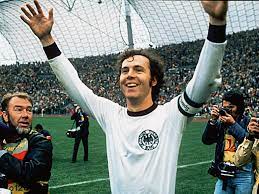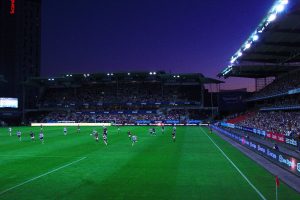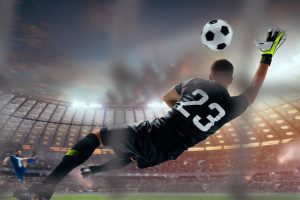How to Play as a Trequartista: A Comprehensive Guide for Soccer Players
As a trequartista, my role on the field is to be the creative force behind the team’s attack. The trequartista, also known as the “number 10,” is a position that requires a player to have exceptional technical ability, vision, and creativity. It is a position that has been made famous by some of the greatest players in history, such as Diego Maradona, Zinedine Zidane, and Lionel Messi.
Playing as a trequartista requires a certain set of skills and attributes. Firstly, a trequartista must be comfortable on the ball and able to hold possession under pressure. They must also possess excellent passing ability and be able to play through balls to the team’s forwards. Additionally, a trequartista must be able to create chances for themselves and others, often through dribbling and quick changes of direction.
| Pros | Cons |
|---|---|
| Can create chances and score goals | May not be suited to defensive responsibilities |
| Can link midfield and attack | May be marked tightly by opposition defenders |
| Can disrupt opposition’s structure with intelligent movements | May require a specific formation to accommodate |
What is a Trequartista?
As a soccer player, I have always been fascinated by the trequartista position. A trequartista is an advanced playmaker who operates behind the striker and is responsible for creating and scoring goals. The word trequartista is derived from the Italian language, where it means “three-quarters.” Essentially, it refers to the position on the field behind the striker and in front of the midfield. A successful trequartista will be a creative player who can spot that killer pass in spaces that appear to lay between heartbeats. Passing, shooting, and using clever movement to create room in a congested box are some of the primary roles a ‘number 10’ would have within the team. They are also expected to play a key role in the team’s attacking play, with their movement and vision helping to unlock opposition defenses. The trequartista is a position that has evolved over time, with different managers and teams using the role in different ways. Some teams use a 4-3-1-2 formation when deploying a trequartista, while others prefer a 4-2-3-1. Due to their premium attacking talent, they are not expected to carry out defensive duties. To summarise the different views on the trequartista position, I have created the following table:
| View | Explanation |
|---|---|
| Role | An advanced playmaker who operates behind the striker and is responsible for creating and scoring goals. |
| Responsibilities | Passing, shooting, and using clever movement to create room in a congested box are some of the primary roles a ‘number 10’ would have within the team. They are also expected to play a key role in the team’s attacking play, with their movement and vision helping to unlock opposition defenses. |
| Formation | Some teams use a 4-3-1-2 formation when deploying a trequartista, while others prefer a 4-2-3-1. |
| Defensive Duties | Due to their premium attacking talent, they are not expected to carry out defensive duties. |
As you can see, the trequartista is a vital position in soccer that requires a unique set of skills and attributes. In the next section, I will discuss the qualities needed to play as a successful trequartista.
Key Characteristics of a Trequartista
As a trequartista, I am expected to be a key player in the attacking third of the pitch. There are several key characteristics that define the position and are essential for success. These characteristics can be divided into three categories: technical skills, tactical skills, and physical attributes.
Technical Skills
One of the most important aspects of being a successful trequartista is having excellent technical skills. This includes having exceptional ball control, dribbling ability, and passing accuracy. As a trequartista, I need to be able to create scoring opportunities for my teammates and myself. This means that I need to be able to make quick and accurate passes, as well as have the ability to take on defenders and create space for myself and others.
Another important technical skill is shooting accuracy. As a trequartista, I am expected to score goals and create goal-scoring opportunities. This means that I need to have the ability to shoot accurately from distance and be able to finish in the box.
Tactical Skills
In addition to technical skills, tactical skills are also essential for success as a trequartista. One of the most important tactical skills is the ability to read the game and make quick decisions. This means that I need to be able to anticipate the movement of my teammates and opponents and adjust my positioning and movement accordingly.
Another important tactical skill is the ability to understand and execute different attacking strategies. As a trequartista, I am expected to be able to play in different formations and adapt my style of play to suit the team’s needs. This means that I need to be able to work effectively with my teammates and understand the roles and responsibilities of each player on the pitch.
Physical Attributes
Finally, physical attributes are also important for success as a trequartista. One of the most important physical attributes is speed. As a trequartista, I need to be able to move quickly and make quick runs to create space for myself and others.
Another important physical attribute is agility. This means that I need to be able to change direction quickly and be able to move past defenders with ease. Finally, endurance is also important for success as a trequartista. This means that I need to be able to maintain a high level of performance throughout the entire match.
| Key Characteristics | Description |
|---|---|
| Technical Skills | Excellent ball control, dribbling ability, passing accuracy, and shooting accuracy |
| Tactical Skills | Ability to read the game and make quick decisions, understand and execute different attacking strategies |
| Physical Attributes | Speed, agility, and endurance |
Playing as a Trequartista
Positioning
As a Trequartista, my primary role is to create and score goals for my team. I need to be positioned three-quarters up the pitch, playing in the hole between the opposition’s midfield and defense. This positioning allows me to receive the ball from my teammates and create scoring opportunities for my team.
Movement
In addition to positioning, I need to have clever movement to create space in congested areas. I need to be able to make runs into the box and move laterally to create openings for my teammates. My movement should also be unpredictable, making it difficult for the opposition to mark me effectively.
Passing
Passing is a critical skill for a Trequartista. I need to be able to spot that killer pass in spaces that appear to lay between heartbeats. I should be able to play in tight spaces and have the ability to pick out the right pass to create scoring opportunities for my team.
Shooting
Finally, I need to be a threat in front of goal. I should have the ability to shoot accurately from distance and be confident in front of goal. My job is to create and score goals for my team, and I need to be able to finish off the chances that come my way.
| Skills | Importance |
|---|---|
| Positioning | Very important |
| Movement | Very important |
| Passing | Very important |
| Shooting | Very important |
Training to Become a Trequartista
Technical Training
To become a successful trequartista, it is essential to have excellent technical skills. Technical training should focus on improving dribbling, passing accuracy, ball control, and shooting. I practice dribbling drills that involve cones to improve my close control and agility. I also practice passing drills with teammates to improve my accuracy and vision on the pitch. Ball control drills, such as juggling, are also crucial to master.
Tactical Training
Tactical training is essential to understand the role of a trequartista on the pitch. It is crucial to understand the team’s tactics and how the trequartista fits into the system. A trequartista must have a good understanding of the game and be able to read the game well. I watch videos of professional trequartistas to learn their movements and positioning on the pitch. I also practice with my team to understand how to link up with the striker and midfielders.
Physical Training
Physical training is essential to maintain fitness levels and improve endurance. A trequartista must be able to keep up with the pace of the game and have the stamina to play the full 90 minutes. I focus on building my strength and agility through weight training and plyometric exercises. I also practice running drills to improve my speed and endurance.
| View | Summary |
|---|---|
| Technical Training | Improving dribbling, passing accuracy, ball control, and shooting |
| Tactical Training | Understanding team tactics, reading the game, and practicing movements and positioning |
| Physical Training | Building strength and agility through weight training and plyometric exercises, practicing running drills to improve speed and endurance |








